Selective knockdown of hexokinase 2 in rods leads to age-related photoreceptor degeneration and retinal metabolic remodeling
- PMID: 33082308
- PMCID: PMC7576789
- DOI: 10.1038/s41419-020-03103-7
Selective knockdown of hexokinase 2 in rods leads to age-related photoreceptor degeneration and retinal metabolic remodeling
Abstract
Photoreceptors, the primary site of phototransduction in the retina, require energy and metabolites to constantly renew their outer segments. They preferentially consume most glucose through aerobic glycolysis despite possessing abundant mitochondria and enzymes for oxidative phosphorylation (OXPHOS). Exactly how photoreceptors balance aerobic glycolysis and mitochondrial OXPHOS to regulate their survival is still unclear. We crossed rhodopsin-Cre mice with hexokinase 2 (HK2)-floxed mice to study the effect of knocking down HK2, the first rate-limiting enzyme in glycolysis, on retinal health and metabolic remodeling. Immunohistochemistry and Western blots were performed to study changes in photoreceptor-specific proteins and key enzymes in glycolysis and the tricarboxylic acid (TCA) cycle. Changes in retinal structure and function were studied by optical coherence tomography and electroretinography. Mass spectrometry was performed to profile changes in 13C-glucose-derived metabolites in glycolysis and the TCA cycle. We found that knocking down HK2 in rods led to age-related photoreceptor degeneration, evidenced by reduced expression of photoreceptor-specific proteins, age-related reductions of the outer nuclear layer, photoreceptor inner and outer segments and impaired electroretinographic responses. Loss of HK2 in rods led to upregulation of HK1, phosphorylation of pyruvate kinase muscle isozyme 2, mitochondrial stress proteins and enzymes in the TCA cycle. Mass spectrometry found that the deletion of HK2 in rods resulted in accumulation of 13C-glucose along with decreased pyruvate and increased metabolites in the TCA cycle. Our data suggest that HK2-mediated aerobic glycolysis is indispensable for the maintenance of photoreceptor structure and function and that long-term inhibition of glycolysis leads to photoreceptor degeneration.
Conflict of interest statement
The authors declare that they have no conflict of interest.
Figures
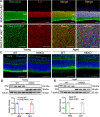
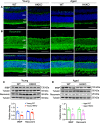
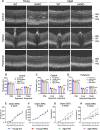

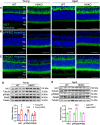
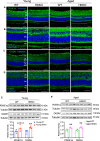
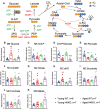

Similar articles
-
The cellular and compartmental profile of mouse retinal glycolysis, tricarboxylic acid cycle, oxidative phosphorylation, and ~P transferring kinases.Mol Vis. 2016 Jul 23;22:847-85. eCollection 2016. Mol Vis. 2016. PMID: 27499608 Free PMC article.
-
Hexokinase 2 is dispensable for photoreceptor development but is required for survival during aging and outer retinal stress.Cell Death Dis. 2020 Jun 4;11(6):422. doi: 10.1038/s41419-020-2638-2. Cell Death Dis. 2020. PMID: 32499533 Free PMC article.
-
Effect of selectively knocking down key metabolic genes in Müller glia on photoreceptor health.Glia. 2021 Aug;69(8):1966-1986. doi: 10.1002/glia.24005. Epub 2021 Apr 9. Glia. 2021. PMID: 33835598
-
Is Retinal Metabolic Dysfunction at the Center of the Pathogenesis of Age-related Macular Degeneration?Int J Mol Sci. 2019 Feb 11;20(3):762. doi: 10.3390/ijms20030762. Int J Mol Sci. 2019. PMID: 30754662 Free PMC article. Review.
-
HK2: a potential regulator of osteoarthritis via glycolytic and non-glycolytic pathways.Cell Commun Signal. 2022 Aug 30;20(1):132. doi: 10.1186/s12964-022-00943-y. Cell Commun Signal. 2022. PMID: 36042519 Free PMC article. Review.
Cited by
-
Single-cell RNA sequencing of the retina in a model of retinitis pigmentosa reveals early responses to degeneration in rods and cones.BMC Biol. 2022 Apr 12;20(1):86. doi: 10.1186/s12915-022-01280-9. BMC Biol. 2022. PMID: 35413909 Free PMC article.
-
Mitochondrial fusion controls the development of specialized mitochondrial structure and metabolism in rod photoreceptor cells.bioRxiv [Preprint]. 2025 May 26:2025.05.21.655403. doi: 10.1101/2025.05.21.655403. bioRxiv. 2025. PMID: 40501800 Free PMC article. Preprint.
-
Reduced nuclear NAD+ drives DNA damage and subsequent immune activation in the retina.Hum Mol Genet. 2022 May 4;31(9):1370-1388. doi: 10.1093/hmg/ddab324. Hum Mol Genet. 2022. PMID: 34750622 Free PMC article.
-
HIPK3 Inhibition by Exosomal hsa-miR-101-3p Is Related to Metabolic Reprogramming in Colorectal Cancer.Front Oncol. 2022 Jan 13;11:758336. doi: 10.3389/fonc.2021.758336. eCollection 2021. Front Oncol. 2022. PMID: 35096570 Free PMC article.
-
VDAC in Retinal Health and Disease.Biomolecules. 2024 Jun 4;14(6):654. doi: 10.3390/biom14060654. Biomolecules. 2024. PMID: 38927058 Free PMC article. Review.
References
Publication types
MeSH terms
Substances
Grants and funding
LinkOut - more resources
Full Text Sources
Molecular Biology Databases
Miscellaneous

